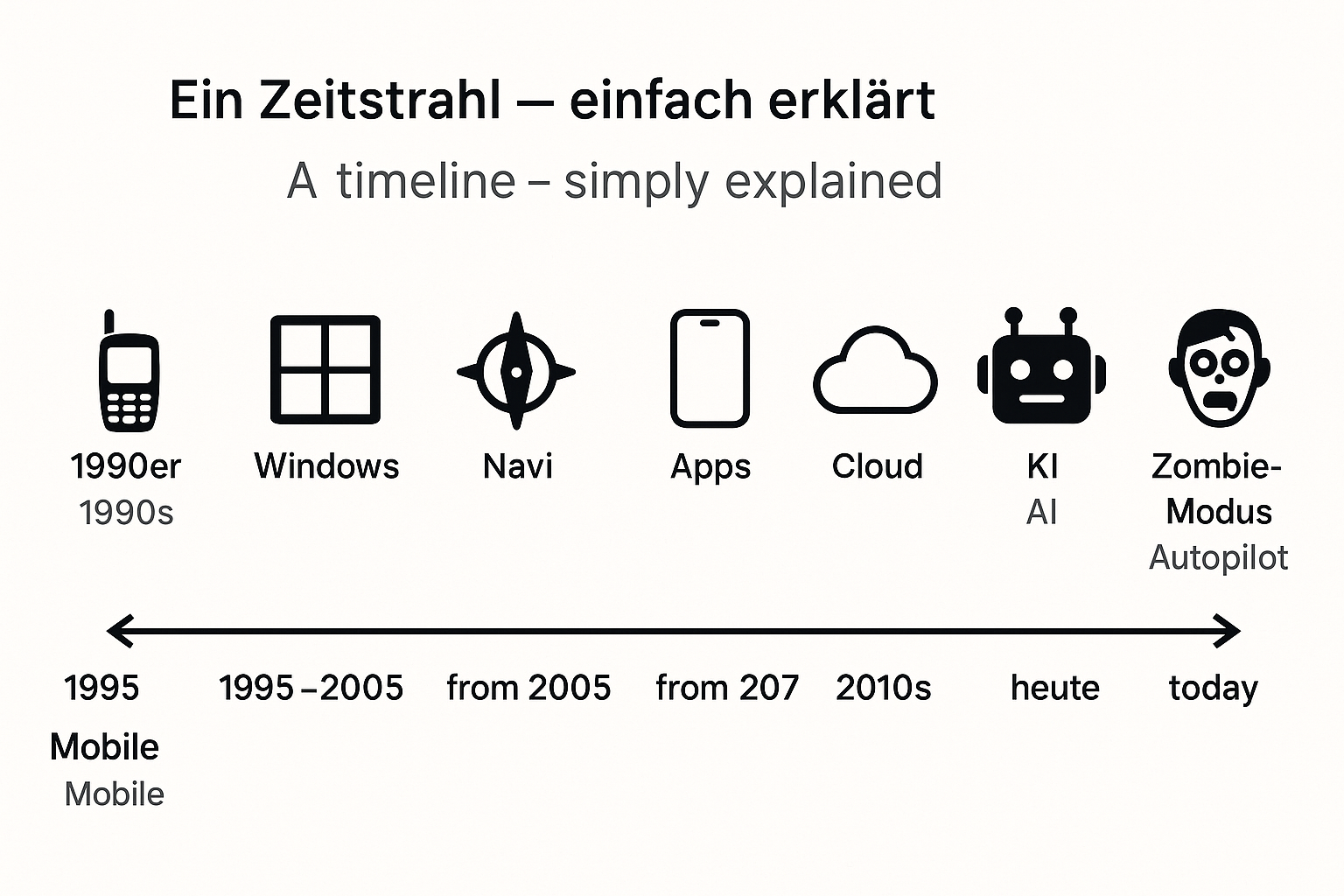Digital Dumbed Down? – How Technology Took Over Our Thinking | 7 Phases Explained

From Thinking to Tapping: How Technology Took Over Our Brains#
A simple timeline through digital dumbing-down—deep, clear, and no-nonsense#
Introduction – Honest question: When was the last time you truly thought?#
Not just googled, not just clicked “OK,” not just followed GPS—but thought for yourself?
The uncomfortable truth: the smarter our devices became, the lazier our brains got. We’ve outsourced more and more: phone numbers, routes, decisions, even our memories.
Sound exaggerated? Take a look at this simple timeline. Instantly understandable—even without tech knowledge.
A timeline – from thinking to convenience#
1990s 1995–2005 from 2005 from 2007 2010s from 2020 today 📞 Mobile ─▶ 🪟 Windows ─▶ 🧭 GPS ─▶ 📱 Apps ─▶ ☁️ Cloud ─▶ 🤖 AI ─▶ 🧟 Autopilot
markdown Kopieren Bearbeiten
Phase 1: The Mobile Era Begins (1990s)#
What happens?
- Payphones disappear.
- We stop memorizing contacts—the phone does it.
- First outsourcing: memory is delegated.
Simply put:
Then: “I know your number by heart.”
Now: “Hold on, I’ll look you up in my phone.”
Phase 2: Windows & Colorful Buttons (c. 1995–2005)#
What happens?
- We used to type text commands (e.g., DOS, an old command line).
- Windows makes everything visual and clickable.
- Technology becomes a black box—functional, yet opaque.
Simply put:
Then: “I know how my PC works.”
Now: “I just click ‘Repair.’ No clue what it does.”
Phase 3: GPS Replaces Thinking (from c. 2005)#
What happens?
- Sense of direction? Unnecessary.
- GPS decides the route—we blindly follow.
- Spatial awareness and map-reading atrophy.
Simply put:
Then: “I navigate by feel.”
Now: “Without GPS, I’m lost.”
Phase 4: Smartphones & Apps (from 2007)#
What happens?
- Everything becomes an app—from communication to creativity.
- The risk of becoming a passive consumer increases.
- Design power shifts from user to app designer.
Simply put:
Then: “I plan, I understand, I create.”
Now: “I tap, I like, I swipe.”
Phase 5: The Cloud Takes Over (2010s)#
What happens?
- Data sits “somewhere”—typically not on your device.
- Control over data? Often consciously relinquished.
- Convenience dethrones responsibility.
Simply put:
Then: “I know where my files are.”
Now: “I hope the cloud saved it.”
Phase 6: AI & Voice Assistants (from 2020)#
What happens?
- Texts, images, answers—all on demand.
- Prompting becomes the new thinking—but still replaces real thought.
- Critical thinking and source awareness decline.
Simply put:
Then: “I think for myself.”
Now: “I just give orders.”
Phase 7: The Zombie Mode – Everyone clicks, nobody thinks#
What happens?
- Systems are operated, not understood.
- Humans run on digital autopilot.
- Even kids learn: there’s an app for everything.
Simply put:
Then: “Thinking was standard.”
Now: “Thinking is optional.”
Conclusion – Clear message#
When you leave everything to technology, it also takes over your thinking.
You lose the ability to solve problems, question, and understand.
It doesn’t make you dumb—but it makes you comfortably dumb. And that is dangerous.
What can you do?#
- Learn how technology works, not just how to use it.
- Don’t believe everything—ask questions.
- Spend time offline—use your brain again.
- Start today: memorize a route without GPS, do mental math, remember a phone number.
Frequently Asked Questions (FAQ)#
1. Does technology really make us “dumb”?
Not directly. But if we use it uncritically, we become mentally lazy—and lose practice in thinking.
2. Are there studies on digital dumbing-down?
Yes. For example, Sparrow et al. (2011): the so-called Google Effect shows we remember less when we know we can look it up later online.
3. How can I train my thinking?
Through reflection, reading, learning, puzzles—and above all: making decisions yourself.
4. Is AI like ChatGPT dangerous?
Not inherently. But if you let it handle everything, you lose connection to sources, logic—and ultimately, understanding.
5. What is “comfortably dumb”?
It means you’re not dumb—but you’re not using your brain because technology does it for you. Convenience replaces awareness.
6. How can I protect children?
Emphasize digital literacy, not just devices. And most importantly: set an example. Show them how to use technology—critically and responsibly.
Final Words#
Technology isn’t the problem.
The problem starts when we stop questioning it—and begin submitting to it blindly.